They say… 
Best beer and travel writing award 2015, 2011 -- British Guild of Beer Writers Awards
Accredited Beer Sommelier
Writer of "Probably the best book about beer in London" - Londonist
"A necessity if you're a beer geek travelling to London town" - Beer Advocate
"A joy to read" - Roger Protz
"Very authoritative" - Tim Webb.
"One of the top beer writers in the UK" - Mark Dredge.
"A beer guru" - Popbitch.

|
Great British Beer Festival Real Ale in a Bottle Bar 2006
ABV: 7.5%
Origin: Burton upon Trent, Staffordshire, England
Website: www.burtonbridgebrewery.co.uk
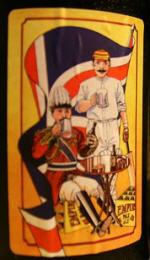 Burton Bridge Empire Pale Ale This is one of the better British revivalist interpretations of the India Pale Ale style, from its spiritual homeland of Burton, brewed with Pipkin pale malt, invert sugar and Challenger and Styrian Goldings hops to a decent ABV.
It’s a gorgeous bronze-gold beer with a low but rich head, a hoppy aroma with ozone and orange zest, and full malty palate supporting assertive slightly vegetal hops. There are iodine and sulphur notes, vanilla and a slightly metallic tang. The hops are very full but not chokingly bitter or harsh, and linger long in a peachy, flowery finish.
Read more about this beer at ratebeer.com: http://www.ratebeer.com/beer/burton-bridge-empire-ale/5827/
Great British Beer Festival Real Ale in a Bottle Bar 2006; also featured as an ale to win lager drinkers in BEER February 2009.
NOTE: This beer was originally briefly reviewed under an earlier name, Double Champion.
ABV: 4%
Origin: Clyst St Lawrence, Devon, England
Website: www.ohanlonsbeer.com
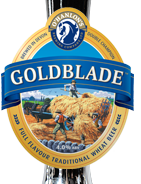 O'Hanlon's Goldblade This is one of several bottle conditioned offerings from this excellent micro in Clyst St Lawrence, Devon. It’s brewed from Optic pale malt, wheat malt and caramalt, with Challenger as the bittering hop, then late-hopped with First Gold and Cascade. Coriander seeds are added, but to subtle effect.
It pours a pale delicate gold with a bubbly white head. A rich and creamy hoppy aroma with definite wheat notes and a whiff of Turkish Delight leads to a dry, clean and quite hoppy palate with a slight banana hint. There’s vanilla and some lightly citric juicy sweetness developing later, followed by a cleansing swallow and a dry, lightly bitter, cereal finish that turns roundedly tangy.
Read more about this beer at ratebeer.com: http://www.ratebeer.com/beer/ohanlons-goldblade/74069/
First published in BEER July 2006 as part of a page about beers from the USA available in the UK. See previous post for more beers from the USA.
ABV: 5.6 per cent
Origin: San Francisco, California, USA
Website www.anchorbrewing.com
 Anchor Porter The Anchor brewery of San Francisco has a special significance both in the US and worldwide as the surviving home of arguably the country’s only genuine pre-Prohibition native style, lager-ale hybrid Steam Beer.
The brewery dates from the 1850s, but was apparently on its last legs by 1965 when businessman and keen Steam Beer drinker Fritz Maytag bought in and started turning things round. Maytag ended up as sole owner, and both he and the brewery became beacons for the blossoming craft brewing movement.
Steam Beer is still a world classic, but its importance shouldn’t detract from the merits of Anchor’s other products, in particular this outstanding brew which pioneered porter brewing in the US when first launched in the early 1970s, at a time when the style was still near-extinct back in England.
The malt grist is a secret recipe but the brewery do admit to using Northern Brewer hops and water from the Hetch Hetchy reservoir, a flooded glacial valley in Yosemite national park.
The result is a very dark ruby, near black beer, with a thin but persistent fawn head. There’s a fruity blackcurrant malt aroma with some cream, liquorice and roast.
The palate is creamily rich but dry, with malted milk, cream toffee, date-like fruit, leather and a note of acidity, soon overlayed by spreading hops. A drying mix of hops and roast develops on a long finish with a charcoal sting, softened by malted milk and fruit syrup.
Truly one of the world’s great dark beers, and an unarguable demonstration of the achievement of US brewers.
Read more about this beer at ratebeer.com: http://www.ratebeer.com/beer/anchor-porter/48/
First published in BEER July 2006 as part of a page about beers from the USA available in the UK. See previous post for more beers from the USA.
ABV: 4.3 per cent
Origin: Chicago, Illinois, USA
Website: www.gooseisland.com
 Goose Island Honker's Ale When marketing man John Hall opened his Goose Island brewpub in 1988, in a district of Chicago once associated with pre-Prohibition brewing, there were only 16 brewpubs in the USA. Hall believed seeing the brewing process in action would help educate the inhabitants of a region in which mass-produced beer was very much part of the culture.
Goose Island now has a purpose built brewery with a capacity of over 100,000 hectolitres a year selling beer across the Midwest. There’s a wide and imaginative range, some of which occasionally pop up in British outlets courtesy of importers James Clay.
Honker’s Ale was one of the brewery’s early lines and still one of their most popular. Reflecting the original aspiration to establish an English-style atmosphere in the brewpub, it’s inspired by British bitters but is still very much an American beer.
It’s a nutty amber brown colour with a good white head and a fairly restrained nutty-malty aroma, with a touch of liquoricey spice and a light hint of coal dust roast – some roasted barley is used alongside pale and cara-malts and wheat.
The firm nutty and biscuity palate has a distinctive fruit edge with a syrup note, lifted by subtle and slowly developing rooty, burry Styrian Goldings hop flavours. Slight roastiness gives a chewy edge to a tangy finish with plenty of peppery hops and resiny, estery notes.
For more beers from the USA see next post.
Read more about this beer at ratebeer.com: http://www.ratebeer.com/beer/goose-island-honkers-ale/811/
Originally published in BEER July 2006 as part of a page about beers from the USA available in the UK
ABV: 5.6 per cent
Origin: Chico, California, USA
Website: www.sierranevada.com
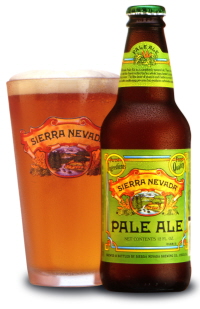 Sierra Nevada Pale Ale With 4 July imminent, I’m raising a toast to life, liberty and the pursuit of happiness with a trio of great beers from that most remarkable of brewing countries, the United States of America.
As with everything else, the USA does beer in a big way. Following the decisive break in the development of the industry caused by Prohibition between 1920 and 1933, and the huge expansion of the market after World War II, concentration and homogenisation got off to an early start.
By the 1970s US brewing was dominated by a handful of huge companies like Anheuser-Busch, Coors and Miller, churning out oceans of nationally marketed bland pale lager derivatives to slake the thirst of what was then the world’s biggest beer market.
The backlash came in the 1980s with a growing movement of home brewers, microbreweries and brewpubs inspired by pioneers like San Francisco’s Anchor Brewery (see below), the success of CAMRA in Britain and the example of the USA’s own increasingly inventive and confident winemakers, who in the 1970s had begun to win international acclaim.
The new wave of brewers have looked across the Atlantic for inspiration in styles and techniques. But as with other cultural borrowings, they’ve applied native verve and enthusiasm to create beers that are distinctively American.
The most obvious national characteristic is the generous use of hops. The assertive fruity and citric flavours derived from local varieties like Cascade and Chinook are the brewers’ equivalent of the vivid fruitiness associated with particular grapes in the country’s varietal wines.
With over 1,500 craft breweries and even the megabrewers reviving specialities, the choice for American consumers is now much improved, especially in big cities. But many craft brewers’ products are unavailable outside their own region, or even their own pub. And only a tiny finds its way to the UK.
One exception is Sierra Nevada Pale Ale, from the Sacramento Valley in northern California. This was the brewery’s launch brand back in1979, and its uncompromising hoppiness helped establish the love affair between US speciality brewers and humulus lupus. It’s still the brewery’s best-selling brand.
With a capacity approaching 1 million hectolitres a year, Sierra Nevada is no longer a micro but still retains impressive quality. The Pale is made from two-row pale and cara-malts and whole hops: Magnum and Perle for bittering and Cascade for aroma. It’s bottle conditioned, though with a very light sediment.
It pours a rich and slightly hazy golden colour, with a bubbly white head that soon subsides. The inviting aroma is rich with spicy pineapple fruit and glycerine.
A light but firm malty palate has pineapple chunks in syrup, gingery spice and a twiggy hop note. But the bitterness saves itself for the swallow, becoming assertive with resin and pepper in a dry finish over spicy sweetish malt.
Though undeniably bitter, the beer stays well-balanced and is far more approachable than some of the “hophead” beers produced by subsequent generations of US craft brewers. It remains a fresh and lively introduction to the country’s reimagining of pale ale.
See the next post for more beers from the USA.
Read more about this beer at ratebeer.com: http://www.ratebeer.com/beer/sierra-nevada-pale-ale-bottle/365/
 Zythos Bierfestival 2010 The Zythos Bierfestival is the flagship event of the Belgian beer consumers’ organisation Zythos, earning multiple stars, a three line whip and a smudge of highlighter pen in many a beer diary, and a great way to get a rounded view of the multifaceted Belgian brewing scene in one fell swoop. It’s also become the focus for several other “fringe” events that take advantage of Belgium’s compact size and good transport and the presence of a solid corps of visiting beer geeks up for a very bleary weekend. Thursday kicked off with the Night of Whisky and Beer, Friday brought the Pré-ZBF Festival and the lambic-themed Nacht van de Grote Dorst (Night of the Great Thirst), while early birds could catch an open brewing day at the legendary Bruxellois lambic brewery Cantillon on Saturday morning before heading off for the first of two days of the ZBF itself. Energetic beer tour organiser Chris “Podge” Pollard was even offering a coach tour that took in the lot and some brewery visits besides.
I’m afraid your author’s alcohol capacity wasn’t up to such a pounding, but I did extend my regular visit to the ZBF proper with a jaunt to the Pré-ZBF, organised, like the Night of Whisky and Beer, by self-proclaimed “picobrouwerij” (picobrewery) Alvinne and in the same location, the Kasteel der Lakenbosschen on the edge of Ruddervorde, a little way south of Brugge. It’s a charming location – an eccentric little rustic castle, in fact a late 19th century romantic architectural confection overlooking a goose pond, with an adjoining orangery that provided a home to the main bars – even if reaching it while remaining within the drink driving laws involves a stretch on the bus from Brugge. Shuttle buses were organised for the occasion as an alternative to the regular service but where they stopped could have been more obvious.
 Menno Olivier of De Molen brewery polishes the bar while his colleague gets down to the real business, Pré-ZBF, Ruddervorde March 2010. Beers on offer at the event are from a limited number of breweries but include some rare and special stuff you’d find very difficult to obtain elsewhere, and there’s the added novelty that some of the participants come from outside Belgium. Alvinne invite like-minded breweries to partner – Struise and De Molen have been regulars and in this third year they were joined by Urthel and two from the UK, Aberdeenshire’s BrewDog and Derbyshire’s Thornbridge. In fact that’s only one genuine Belgian brewer, Alvinne itself. Struise are a Belgian brewing firm that rents equipment at other Belgian breweries, principally Deca; De Molen is a Dutch brewer, from Bodegraven in Zuid-Holland; and Urthel are a Belgian firm that contract brew at Koningshoeven, the semi-secularised Trappist brewery at Berkel-Enschot in Dutch Noord Brabant.
If you know anything about this bunch you’ll realise this was primarily a beer geek event drawing an international crowd, and indeed there was a ratebeer / Beer Advocate / Burgundian Babble Bent tent providing “bring and taste” accommodation, and as much English being spoken as Dutch. Most of the brewers are known for small runs, limited editions, high gravities, no-holds-barred experimentation and a penchant for wood ageing in refill casks – the sort of beers that tend to score highly among the regular raters of the online beer world. In this company, Urthel, whose beers are normally thought of as eccentric, looked almost ordinary.
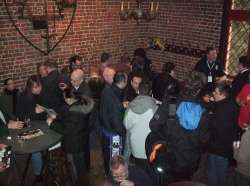 The crowd enjoying Thornbridge beers, Pré-ZBF 2010, Ruddervorde March 2010. Alvinne had the biggest range with versions of their strong beers from various casks, and, at a slightly more sessionable strength, the rather decent Chelmsford Smoked Porter (see tastings). Struise had supplies of their cult hits like Pannepot and Aardmonnik and lots of more unusual stuff too. De Molen had a dazzling eclectic range including some special versions of their regulars. BrewDog brought their silly gravity Tactical Nuclear Penguin, at 36% and €15 a shot, as well as their low gravity beer Nanny State, but all in filtered bottles. Thornbridge were overwhelmed with the popularity of their beers, particularly the cask aged Alliance and St Petersburg specials.
I was glad to have made the trip – I tasted some very impressive beers, bought some interesting rarities at the onsite offie and had some great conversations. But while I’m full of praise for brewers so full of energy, inspiration and a determination to push the envelope, I found myself longing just a little for beers aimed at ordinary mortals, and ones that are likely to be readily available for some time to come, so that writing about them doesn’t just feel like showing off.
 Under the palms on a freezing Flemish day, ZBF 2010, Sint-Niklaas, March 2010. That’s certainly not a problem at the main ZBF, now in its seventh year. It’s the Belgian equivalent to CAMRA’s Great British Beer Festival and although it can get very busy and lively it’s still on a notably smaller and more approachable scale. The venue is the Stadsfeestzaal (The Town Festival Hall) almost opposite the station at Sint-Niklaas, on the line between Antwerpen and Gent and with regular services to many other Belgian towns. It’s a bit of a soulless municipal venue that must look like a vast concrete-floored barn when empty, but it soon comes alive with drinkers of all kinds. Yes, it’s got an obvious following among members of Zythos, CAMRA and Dutch beer organisation PINT, and pulls a good few beer fans across the Atlantic, but like all good festivals it attracts its fair share of ordinary people too– folk who enjoy good beer without being obsessed with it making it a day out from Bruxelles, Antwerpen or Eindhoven, and curious locals just passing by. The latter will be encouraged by the fact that there’s no admission charge, just a €3 deposit on the tasting glass. To get it filled you need to buy a supply of jetonnetjes, plastic tokens that are the only form of currency accepted at the bars, at the cost of €1.20 a 150ml measure.
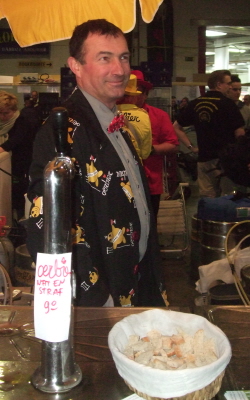 Kris Herteleer models Dolle Brouwers chic, ZBF 2010, Sint-Niklaas March 2010. Unlike British festivals, where long bars staffed by volunteers offer a range from different brewers, ZBF has a series of small stands for each brewery or beer firm — ‘bierfirma’ being Zythos’ term for brewers without breweries that contract brew or hire other people’s kit, of whom there are quite a few in Belgium. The stands are staffed by the breweries, though Zythos volunteers do everything else. Often you’ll find the brewers themselves behind the taps – Kris Herteleer from De Dolle Brouwers is a mainstay at their stand in his trademark novelty jacket and bow tie. This year there were a record 61 brewers represented, just about half of all the brewers in Belgium, offering over 280 beers.
The beers cover a huge range. It’s always a pleasure to see some of the smaller older-established independents like SAS (formerly known as Leroy) and Strubbe offering traditional everyday beers that can be particularly hard to find outside their own core distribution areas. Rarer still are the handful of unblended lambics that the festival can always be relied upon to exhibit. Newer micros are well represented, often with something unusual to showcase as well as their regulars, and it’s particularly good to see some of the excellent Wallonian craft brewers such as Écaussines, Jandrain-Jandrenouille, Rulles and Sainte-Hélène at what is still a slightly Flemish-dominated event.
Off on a side hall where the seating is less hotly contested are a number of food stands all doing rather basic fast food – filled rolls, burgers, and the inevitable paper cones of chips drowned with industrial mayonnaise. The veterans come prepared with their own packed lunches, snacks and large bottles of water, vital for soaking things up and pacing yourself given the strength of some of the beers.
One thing that will irritate British and North American first-time visitors is that Zythos recoup some of their investment by demanding 30c for every visit to the loo. Charging for public toilets is of course the norm in Belgium as in a number of other countries, but charging for them at a beer festival is a bit like charging hens for laying eggs, and considerably more of a dead cert as a fundraising initiative than skittles or tombola. That niggle aside, this is one of my favourite beer events.
Among other people I bumped into beer historian extraordinaire Ron Pattinson, who gave me a fascinating book on beer recipes in Britain in 1907. Ron’s writeup of the event is on his blog at http://barclayperkins.blogspot.com/2010/03/zbf-2010.html.
Selected tastings:
Pré-ZBF
- [intlink id=”630″ type=”post”]Alvinne Chelmsford Oak Smoked Porter[/intlink] 5.3%, Heule, West-Vlaanderen
- [intlink id=”634″ type=”post”]Deca / Struise Aardmonnik[/intlink] 8%, Woesten-Vleteren, West-Vlaanderen
- [intlink id=”637″ type=”post”]Thornbridge St Petersburg Whisky Reserve[/intlink] 2006 8.8%, Ashford-in-the-Water, Derbyshire, England
ZBF
- [intlink id=”640″ type=”post”]Dochter van de Korenaar Noblesse[/intlink] 5.5%, Baarle-Hertog, Antwepen, Vlaanderen
- [intlink id=”648″ type=”post”]Écaussines Ultrabrune d’Écaussines[/intlink] 10%, Écaussines d’Enghien, Hainaut, Wallonie
- [intlink id=”644″ type=”post”]Oud Beersel Oude Lambik[/intlink] 5%, Beersel, Vlaams Brabant, Vlaanderen
Zythos Bierfestival 2010
ABV: 10%
Origin: Écaussines d’Enghien, Hainaut, Wallonie
Website: www.brasserieecaussines.be
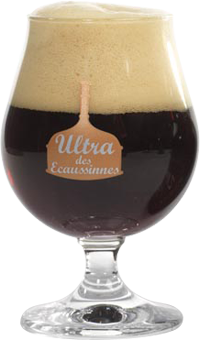 Ultrabrune d'Écaussines This new generation farmhouse brewery, founded in 2000 by Hugues and Isobel Van Poucke, tends to pop up more in the export market than in Belgium, so it was great to see them represented with a full range of bottle conditioned ales among a number of Wallonian micros at the Zythos Bierfestival.
Ultrabrune is a big sweetish brown ale, reminiscent of the high alcohol brown Trappist and abbey beers such as Rochefort 10, though with rather more overstated flavours. It’s brewed using pale malt, two different caramalts and torrefied malt, and comes out a cloudy deep ruddy-brown with a creamy yellowish head and an intoxicating dark malt and herb aroma. A full and dark malty and herby palate has lots of flavoursome estery notes, some fresh fruit, raisins and chocolate.
Red fruit rises on the swallow, and there’s more chocolate on a notably sweet, roasty and generously fruity finish that’s very light on hops. I suspect this could mature into something even more interesting.
Read more about this beer at ratebeer.com: http://www.ratebeer.com/beer/ultrabrune-10/11031/
Zythos Bierfestival 2010
Top Tastings 2010
ABV: 5%
Origin: Beersel, Vlaams Brabant, Vlaanderen
Website: http://www.oudbeersel.com
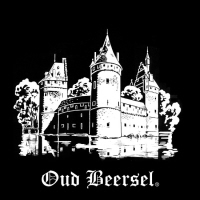 Oud Beersel brouwerij en geuzestekerij Oud Beersel in the heart of Pajottenland’s lambic country was the brewery that unexpectedly came back. Originally named Vandervelden after the owning family, it closed its doors in 2002 when the last Vandervelden retired, but two beer enthusiasts, Gert Christiaens and Ronald de Bus, started a campaign to reopen it, buying the brand name and the brewery and contract brewing a non-lambic beer, Bersalis, to bring in a cash flow rather more quickly than the long maturation period of new lambic beer would have provided. At first the relaunched Oud Beersel acted as a geuzestekerij, blending old Vandervelden lambics and beers from other lambic brewers, but in Autumn 2007, as the brewery marked its 125th anniversary, the owners announced new lambics were once more being produced.
I’m not sure quite where the mature unblended lambic being served from polycask at the Oud Beersel stand at this year’s Zythos Bierfestival originated — it’s just possible it was one of the early revival brews, which would now have had over two years to mature. In any case it was a very rich and complex beer, and notably rounded and mild for the style.
It poured a still deep golden with no head, giving off a malty, woody, slightly petrolly aroma with grape juice and rough cider notes. A thick fruity sweet-sour palate started with peaches and then turned tart, lemony and woody, with a wonderfully animated sense of developing flavour. A citric swallow led to a rounded and full sappy finish with notes of apricot, mature cheese and nuts. Definitely a lambic on the mellower side but none the worse for it.
Read more about this beer at ratebeer.com: http://www.ratebeer.com/beer/oud-beersel-oude-lambik/23561/
Zythos Bierfestival 2010
ABV: 5.5%
Origin: Baarle-Hertog, Antwerpen, Vlaanderen
Website: www.dedochtervandekorenaar.be
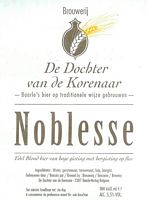 De Dochter van de Korenaar Noblesse De Dochter van de Korenaar — the Ear of Grain’s Daughter — is one of the remote outposts of Belgian brewing, in boundary boggling Baarle-Hertog, a tiny and irregularly shaped enclave of Belgium — less than 8km² divided over 24 seperate pieces of land, sometimes with buildings straddling the border — entirely surrounded by the Netherlands, the legacy of mediaeval land grabs between the rulers of Breda (now the Netherlands) and Brabant (now Belgium). In the early days of this brewery I had a couple of dodgy bottles, but there was no problem with this delightful easy-going blond ale, the brewery’s first beer, sampled on draught at the Zythos Bierfestival.
It’s a warm, hazy gold with a little off-white, slightly pinkish head and a creamy, malty, fairly restrained aroma. A firm and smooth malty palate has a slight herbal note, with bitter hops and citrus developing, offset by a gentle sugary touch. A creamy mouth-coating finish has herbal and flowery notes and a gentle bitterness, finishing dry, a testament to the Belgian brewing’s tentative rediscovery of the hop. My decision certainly wasn’t split: it’s notably complex for the ABV, but very well balanced, and altogether a refreshing delight.
Read more about this beer at ratebeer.com: http://www.ratebeer.com/beer/de-dochter-van-de-korenaar-noblesse/78107/
Pré-ZBF Festival 2010
Top Tastings 2010 (Highland)
ABV: 8.8%
Origin: Ashford-in-the-Water, Derbyshire, England
Website: www.thornbridgebrewery.co.uk
 Thornbridge Hall Thornbridge are emerging as a world class new brewery, offering a solid range of excellent everyday beers but also knowing how to push at the boundaries of style while still retaining good taste and balance. Witness the popularity of these wood-aged imperial stouts at the Pré-ZBF event this year, where they lined up alongside cult iconoclasts BrewDog, Struise and De Molen.
St Petersburg is Thornbridge’s regular imperial stout and back when this batch was brewed in 2005 it was made from Maris Otter pale, Pilsner, dark crystal and chocolate malts, roasted barley and Bramling Cross and Galena hops. The beer was then aged in whisky barrels for around nine months, and bottled in mid-2006, since when as a bottle conditioned beer it has continued to evolve.
St Petersburg Speyside Whisky Reserve was matured in a cask from the Mortlach distillery, and now emerges almost black, with a fine foamy beige head. A treacly, very lightly sour and oaky aroma has a touch of smoky whisky, heralding a thick and rich palate, smooth and tasty despite the obvious alcohol, with chocolate, coffee, raisin and sherry notes. A beautifully mellow finish is lightly oaky with dark malt, a building woody dryness and a slightly bitter note.
If the Speyside is a refined and mellow beer, the Highland Whisky Reserve version, matured in a Macallan cask, is better still, full of vivid and unusual flavours but well-integrated and satifsying. This has a smooth and creamy but very dark and tarry aroma, with notes of varnish and a slight hint of cardboardy oxidation. A slick, sherried and honeyed malt palate has handfuls of fruit and nuts as well as wood, and there’s a minty, slightly cedary disinfectant-like note on a long developing finish that’s coffee bitter and slightly phenolic, ending with pursing tannins and an impression of sucking on wood.
Following a conversation at the festival, I’m delighted to discover it was partly my positive review of the standard version of St Petersburg that encouraged Kelly Ryan, then newly arrived from New Zealand, to apply for a job at Thornbridge following the departure of Martin Dickie to found BrewDog — Kelly is now a key member of their brewing staff.
Read more about these beers at ratebeer.com:
http://www.ratebeer.com/beer/thornbridge-st-petersburg-imperial-russian-stout-highland-whisky-reserve/100203/
http://www.ratebeer.com/beer/thornbridge-st-petersburg-imperial-russian-stout-speyside-whisky-reserve/100179/
|
Cask  This pioneering new book explains what makes cask beer so special, and explores its past, present and future. Order now from CAMRA Books. Read more here. This pioneering new book explains what makes cask beer so special, and explores its past, present and future. Order now from CAMRA Books. Read more here.
London’s Best Beer  The fully updated 3rd edition of my essential award-winning guide to London’s vibrant beer scene is available now from CAMRA Books. Read more here. The fully updated 3rd edition of my essential award-winning guide to London’s vibrant beer scene is available now from CAMRA Books. Read more here.
|


















